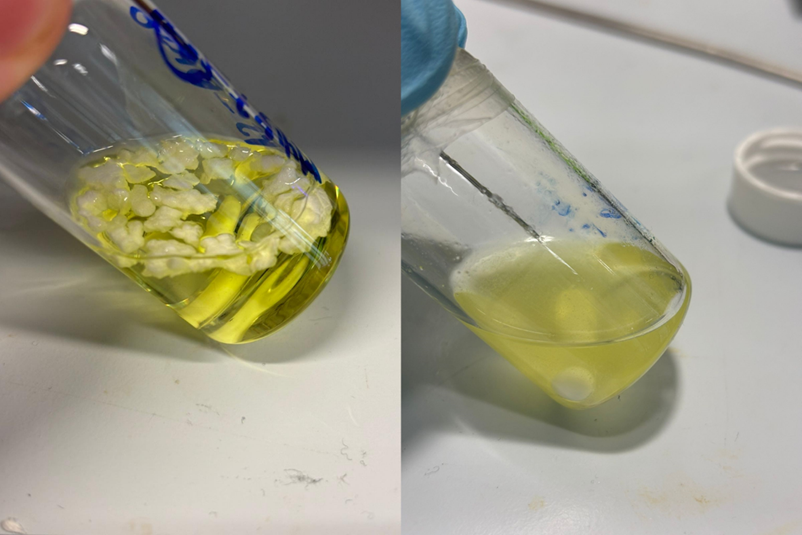Chemical engineers at UNSW have used sunlight, a common chemical with a solvent and the air around us to reduce tough polymers into reusable, raw materials.
Engineers at UNSW have developed a sustainable and low-energy way of breaking down a wide range of plastics, including polystyrene, using just sunlight, air and a common chemical compound used in high school experiments.
The process works at room temperature and uses iron trichloride (also known as ferric chloride), which is cheap and widely available, in combination with exposure to light and oxygen.
The research was recently published in Macromolecular Rapid Communications.
The team has shown it can break down seven distinctive types of polymers by 90% in less than 30 minutes. The reduction increases to 97% after three hours.
Dr Maxime Michelas, a researcher from the School of Chemical Engineering working in Professor Cyrille Boyer’s group, says it could provide ‘significant benefit’ for the world.
“I think it’s very important to degrade the polymer and turn it into another feedstock we can use for other things, or just to reduce the amount of microplastics in the world.”
(Above: Related work from the research team that shows polystyrene breaking down in solvent. The published research in this story differs as the polymers in those experiments were already dissolved. PHOTO: UNSW – Maxime Michelas and Cyrille Boyer)
How it works
Prof. Boyer and his team have found their process works on polymers that include polyvinyl chloride, the PVC from your common drainpipe, and poly(ethylene glycol), a widely-used polymer that’s found in cosmetics and pharmaceutical products.
The polymer must be dissolved with a solvent before starting the degradation process.
From there, simply exposing the solution to ferric chloride and a light source breaks down the solution which eventually becomes clear.
Prof. Boyer’s team first used dim, purple light in a controlled environment with pure oxygen. Starting and stopping the degradation process was as simple as turning the light switch on and off.
When the team used sunlight instead of purple light and exposed their test environment to ambient air the process still worked, it was just a little slower.
“Our proposal here is to make the simplest system to degrade polymers,” Dr Michelas says.
He says the project is inspired by previous research in the area where electricity was used to try to create the same reaction.
“The problem with the previous approach is you need a lot of different things, like electrodes, or co-solvents, or co-initiators, or co-catalysts, so the system is more and more complex.
“More importantly, the previous system only was able to degrade a limited range of polymers. In our study, we successfully expanded the range of polymers, including polyvinyl chloride, poly(meth)acrylates (typically used in various products, such as paint), and polyvinyl acetate.”
Prof. Boyer says waste management services could use the process at their sites. From there, the remaining product could become raw material for another product.
“We are creating very simple organic compounds (such as acetone) after the degradation of these polymers,” Prof. Boyer says. “These molecules can then be further degraded by bacteria, for example, and completely removed from the environment or reused as feedstock to create new polymers.”
Current limitations
While the process of breaking down the polymer with sunlight, air and ferric chloride after it’s been dissolved by solvent is environmentally friendly, the use of solvent presents some limitations.
“We need to use an organic solvent, and unfortunately our system is not compatible with water,” Prof. Boyer says.
“If it was, we would directly use it in water, degrade the plastic or the microplastic present in wastewater to form small organic compounds that could be digested by bacteria using a bioreactor.”
Prof. Boyer says there’s also some tinkering needed with the byproduct that comes out at the end of the process.
“We can degrade the plastic, but we don’t control what exact product we are making when it degrades.”
Why it’s important
According to , the total amount of plastic consumed in Australia has more than doubled since 2000. By 2049, it will more than double again.
Dr Michelas refers to the Great Pacific Garbage Patch (GPGP) when discussing his work. From 2018 figures, the GPGP is estimated to be 79,000 tonnes of ocean plastic floating inside an area of the North Pacific Ocean that’s twice the size of Texas.
“Plastics have brought significant benefit for the world, but this is a monumental issue,” he says.
Prof. Boyer’s team is working on finding new catalysts that can operate in water, which would be beneficial for the environment.
And while one of their key goals is making the process as simple as possible, they’re also looking for a way to break down the polymer without the use of a solvent at all.
Prof. Boyer says the work continues by exploring new catalysts.
“If we can find a catalyst that works in water, I think this will open a lot of opportunities.”
Key Facts:
Chemical engineers at UNSW have used sunlight, a common chemical with a solvent and the air around us to reduce tough polymers into reusable, raw materials.








